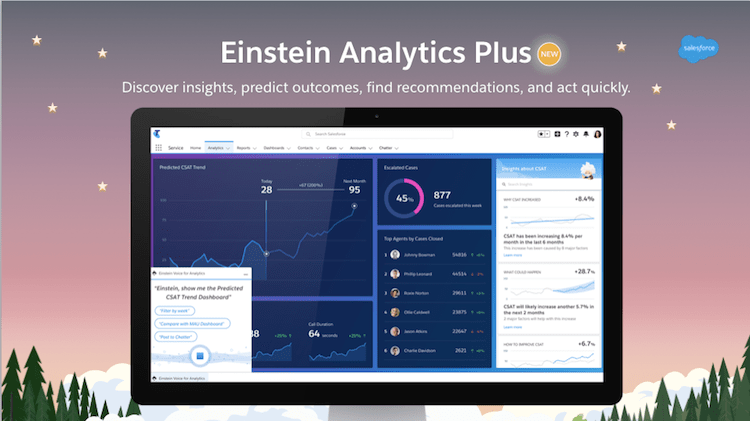
“Data-driven” is a phrase that's thrown around a lot — from buzzwords like data-driven marketing, data-driven outreach, data-driven approach; the list goes on. But it doesn't mean that anyone needs more data — what we really need is insights we can act on.
The singular purpose of analytics is to give you insights, and those insights should not just shine a spotlight on the past but more importantly show you what's ahead of the curve. Business users have been waiting, hoping, and praying (ok, maybe not praying, but desperately hoping!) for the analytics tools that give them such insights.
However most classical analytics tools that produce visualizations were built for the simpler days: when small data was hip, it was acceptable to wait months for analysis, and confirmation bias was cool. For generations, analytics dashboards were clumsy, monolithic and mostly told us what had already happened.
We are now at the cusp of a new generation of analytics and 2018 will go down as the year when analytics — which was traditionally a back-office function that supplied stale data about the past — moved into the front-office, empowering all business users with real-time actionable insights at every point of decision making. AI has revolutionized the humble dashboard, elevating it to a whole new level and a crucial strategic tool.
In this new, transformed intelligent experience, it's not about the data, but about the insights:
- You are no longer manually searching for data; insights find you.
- Insights are predictive, guiding you on what may happen and what action to take.
- Insights and recommendations are infused within your workflow and business context.
- Insights are delivered in a narrative format that provides greater context about a situation and possible results of your action.
If you are not getting this level of insights, your analytics tool is outdated. You need to trade in that flip phone (or leave it at nearest e-waste center) and get yourself a smartphone! It's time to make some new year's resolutions for your data — here are 6 must-have capabilities you should have in 2019:
- Automated Discovery (Built-in AI): We’re drowning in data and synthesizing billions of data points is something that humans simply weren’t wired to do. Built-in AI automates the process of discovering insights and making predictions from massively large amounts of complex data. This is a must-have and the foundation of what Gartner calls “Augmented Analytics.”
- Outcomes-Focused (Predictive analytics): Predictive Analytics is imperative for every business. You don't need yet another visualization that tells you about the past (especially if the past was not that good!). You need better ways to predict the future. Imagine a chart that shows a trend line of not just what happened but extends beyond today to give you a glimpse of the future — now that's what I mean by insights!
- Complete Integrated Stack: You should spend more time analyzing and less time integrating. Too often, analytics is siloed, requiring people to pivot between different tools and systems. Your analytics product should be able to deliver the complete analytics spectrum from descriptive(visualizations), to diagnostic, to predictive and prescriptive — all in one integrated experience. Would you like to have 5 devices in your pocket — one for making phone calls, one for checking email, one for browsing the web, one for taking pictures and one for getting directions? No! You need an integrated communications device (aka, a smartphone!). Similarly, you need the smartphone equivalent of analytics. One integrated experience
- Actionable (data-driven): An insight that does not lead to action is just a dumb chart. Analytics tools have to provide the ability to seamlessly connect with the underlying business process so that you can act on the insight.
- Simple is the new Black: No-code AI is no longer an optional feature or an add-on accessory you have to pay extra for. Any analytics technology you want to get use out of needs to be dead simple: it should be intuitive and click-based, and you shouldn't need to hire a SWAT team of data analysts. You should not need to have an advanced degree in mathematics and computer science or data analysis to interpret data.
- Trusted & Transparent: And most of all, you have to trust the insight. Your AI-powered analytics product should provide full access to the underlying model used to generate the diagnostic story and prediction. The model needs to explain itself and the explanation needs to be in plain human speak. Just outputting a predicted number or score is not good enough. Along with it, the product needs to provide an explanation of the factors that drove that result. Model measurement, feedback loops & bias protection are tables stakes.
When you have these capabilities built into your analytics, your teams can spend more time engaging with customers and less time wading through data lakes and data puddles. The analytics industry has talked about actionable analytics for a while, but in 2019, AI + Analytics is finally making the needs of the modern business user a reality.
Check out Dreamforce 2018's Analytics Keynote: AI + Analytics for Every Business Process to learn more and check out our newest Einstein Analytics and Discovery Insights Specialist Superbadge to get hands-on experience with Einstein Analytics Plus!
P.S. Einstein Analytics is a complete analytics platform for any data: CRM and beyond.

